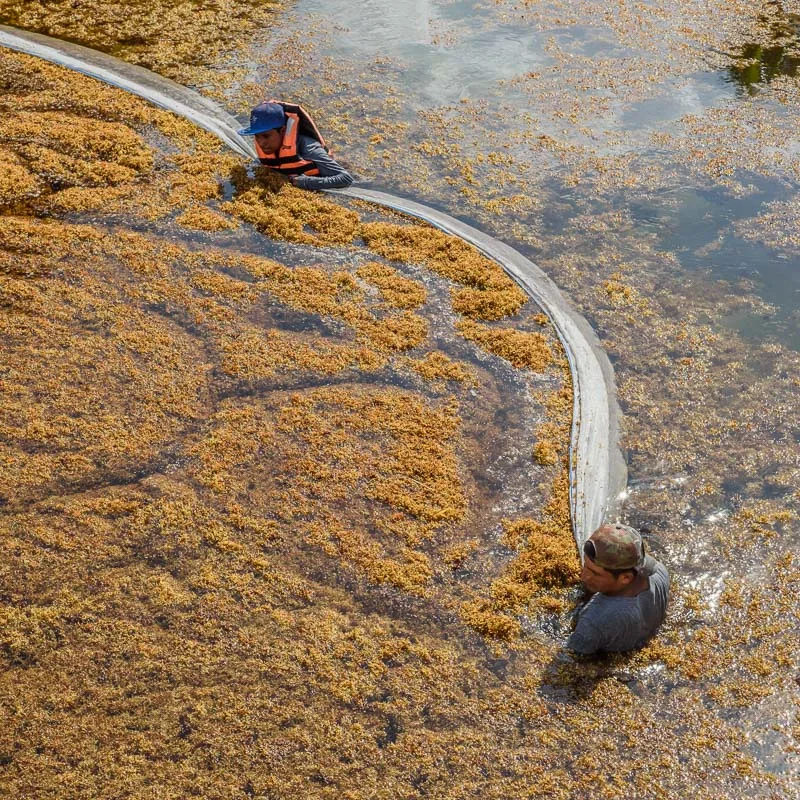Last Updated
New reports are suggesting that Quintana Roo’s sargassum season could be the worst in five years, worrying the tourist industry. Tens of thousands of tons of seaweed have already been deposited on beaches across the Caribbean. Sargassum is a brown type of seaweed that is known for accumulating on Cancun beaches during the spring and summer months.

The National Autonomous University Of Mexico has been following the sargassum since it first began appearing in large quantities back in 2014. The levels steadily increased, peaking in around 2018/2019 before showing signs of a slight dip in 2020. There is some speculation that this may have been attributed to the pandemic and the drop in carbon usage across the planet that came with it.
However, 2022 is seeing deposit rates and volumes that are higher than those in 2018. At least 32 thousand tons have been forecasted to arrive on Quintana Roo’s beaches over the coming weeks- an extremely high volume.

Sadly, the state is unable to keep up with the deposits despite its best efforts. Multiple methods are used in the fight against sargassum. Early detection is captured using drones, hot air balloons, and planes as well as satellite imagery from universities that study the natural phenomenon. It was hoped that the early detection would allow the navy to retrieve large amounts of the seaweed before it hit the shore, but multiple problems have surfaced preventing that from happening.

The Navy released 26 ships from Chetumal two weeks ago with the sole purpose of dealing with the sargassum, but poor weather is hampering the efforts. At least two of those ships are sargacerro ships, large vessels designed to collect masses of seaweed far out at sea. In theory, the high volumes these ships could pick up can make life much easier, but each year the ships are having a decreasing impact on the effort.
According to the statistics, 2020 saw the Navy pull only 4% of the seaweed collected from the ocean. 3% of the collected sargassum in 2021 was collected from the sea. 2022’s collection rate is down at 1%, meaning that 99% of all the seaweed reaching the Mexican Caribbean is being collected manually by workers on the beach.

The amount of workers needed to clear the beaches is severely hampering businesses’ bottom lines. Most hotels reported considerable drops in profit despite having extremely strong years in terms of occupancy. The amount being spent to hire people to clean the beaches in the morning is eating into profit margins, and when combined with remaining COVID restrictions like masks, enhanced cleaning, and other precautions it could spell rate increases for tourists.
For those unaware of sargassum, it may seem like a small problem. In reality, it’s one of the biggest issues facing the Caribbean. The seaweed forms into massive island-like tangles far out in the Atlantic Ocean, and drifts on ocean currents towards the Caribbean. At sea, it poses virtually no problems for the tourism industry and is actually an important ecosystem for many small sea creatures.

When it approaches land, it becomes more complicated. When it reaches the shallows, it transforms the typically crystal blue waters of the Mexican Caribbean into a murky brown, ruining the aesthetic that so many travel to the region for. On the sand, it piles up as high as a meter, having a similar impact as the brown water.

The biggest problem is the smell. Once on land, the sargassum begins to break down and produces a putrid sulfur-like smell in the process. Any tourists nearby avoid it, and beaches are often empty when the deposits are heavier.
Many tourists go as far as canceling their vacations if they’re aware of large deposits as the beach is such an integral part of the experience.

Hotels have started giving regular updates on the sargassum situation, and tourists are advised to check in with their accommodation to help avoid disappointment.
Plan Your Next Cancun Vacation:
Traveler Alert: Don’t Forget Travel Insurance For Your Next Trip!
Choose From Thousands of Cancun and Riviera Maya Hotels, Resorts and Hostels with Free Cancellation On Most Properties
↓ Join the community ↓
The Cancun Sun Community FB group has all the latest travel news, conversations and tourism Q&A’s for the Mexican Caribbean

Subscribe to our Latest Posts
Enter your email address to subscribe to The Cancun Sun’s latest breaking news affecting travelers, straight to your inbox.

Marcos hanson
Saturday 28th of May 2022
Ever since cruise ships came into the region by the drove, dumping their sewage into coastal waters seagrass has been a problem,,, the same thing happened to key west, 18 yrs ago I'm telling you that is the problem,,, but cruise ships create so much revenue,, you are not going to admit it and listen to me😢🤬